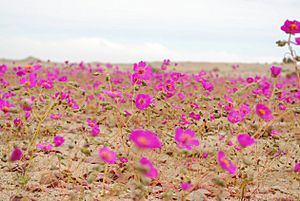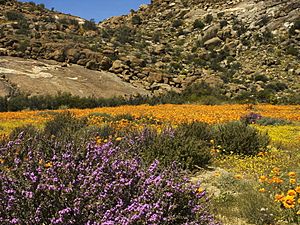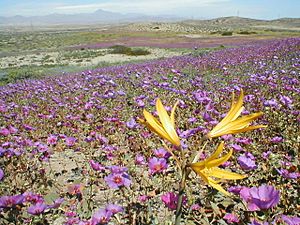Desert bloom facts for kids
A desert bloom is a special natural event. It happens in many deserts around the world. This event is when lots of different flowers suddenly bloom. It usually occurs in early to mid-spring. This only happens in years when there is much more rain than usual.
The flowers bloom because the extra rain reaches seeds and bulbs. These seeds and bulbs have been "sleeping" in the dry ground. The rain makes them wake up and start to grow. When the flowers appear, many insects, birds, and small lizards also become more active.
Contents
Around the World
Chile
In the Atacama Desert of Chile, a desert bloom is called desierto florido. This means "flowering desert" in Spanish. It happens between September and November. This is only in years with unusually high rainfall. Normally, the Atacama Desert gets less than 12 millimeters (about half an inch) of rain each year.
When the flowering desert is at its best, you can see it in many places. It stretches from just south of Vallenar to just north of Copiapó. You can see it in the coastal valleys and the Chilean Coast Range.
This amazing event is linked to something called the El Niño phenomenon. El Niño is when the ocean water off the coast of South America gets unusually warm. This warm water can cause more water to evaporate. This leads to more rain falling in the desert.
The flowering desert is a very popular place for tourists. People come to see it from towns like Huasco, Vallenar, La Serena, Copiapó, and Caldera.

Plants and Animals
The flowering desert brings to life over 200 types of flowers. Most of these flowers are found only in the Atacama region. Different kinds of flowers grow at different times during the bloom. Some common flowers include:
- Lion's Claw (Bomarea ovallei)
- Guanaco's Paw (Cistanthe grandiflora)
- Añañuca (Rhodolirium montanum)
- Schizopetalon tenuifolium
This area is also home to cacti and succulents. These are plants that can live in very dry places. You can also find animals like the Tuco-tuco and the Four-Eyed Frog.
Protecting the Desert Bloom
In recent years, people have worried about protecting the flowering desert. Many tourists can accidentally harm the plants. There is also illegal selling of native flowers. Even motorsport events can damage the area. These activities can make it harder for the flowers to grow back.
To help protect the desert, the Chilean Government has made new rules. They have also started campaigns to teach people, especially tourists, how to visit safely. A special group called the Comisión del Desierto Florido was created in 1997. It was restarted in 2015 to find ways to protect the desert bloom.
In June 2022, the city of Copiapó passed a local law. This law sets fines for anyone who damages the desert bloom. On October 2, 2022, the Desierto Florido National Park was officially announced. This park will help protect this unique natural wonder.
How Rainfall Affects Flowering
The desert bloom needs more rain than usual. However, too much rain can actually stop the flowers from blooming well. For example, in 1997, the region had a lot of rain. Copiapó received 129.4 millimeters of rain, which was much more than usual. Vallenar received 168.5 millimeters. But even with all that rain, there was only a small desert bloom.
In March 2015, some parts of the area received 23 millimeters of rain in just one day. This rain came from an El Niño event. This led to a beautiful flowering in September and October of 2015.
Peru
In Peru, a desert bloom also happens in the south and north of Lima. This occurs between September and November. What's special about the Lima desert bloom is that it reaches up into the highlands. This is because clouds get "stuck" there and drop water. Another unique thing is the green moss that appears.
United States
See also
 In Spanish: Desierto florido para niños
In Spanish: Desierto florido para niños
- Related to desert blooms in Chile
- Diaguita
- Transverse Valleys



